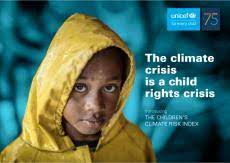In 1989, virtually every country in the world agreed children have rights to a clean environment to live in, clean air to breathe, water to drink and food to eat. Children also have rights to learn, relax and play. But with their lack of action on climate change, world leaders are failing this promise.
The Children’s Climate Risk Index ranks countries based on how vulnerable children are to environmental stresses and extreme weather events. It finds children in the Central African Republic, Chad, Nigeria, Guinea, and Guinea Bissau are the most at risk. And yet these countries are among those least responsible for creating the problem, with the 33 extremely high-risk countries collectively
emitting just 9 per cent of global CO2 emissions. In contrast, the 10 highest emitting countries
collectively account for nearly 70 per cent of global emissions. Only one of these countries is ranked
as extremely high-risk in the index.
We must acknowledge where we stand, treat climate change like the crisis it is and act with the
urgency required to ensure today’s children inherit a livable planet.
–From The Climate Crisis is a Child Rights Crisis
Introducing THE CHILDREN’S CLIMATE RISK INDEX
This UNICEF Report was released in August 2021, ahead of the recent COP26. The climate crisis is a child rights crisis presents the Children’s Climate Risk Index (CCRI), which uses data to generate new global evidence on how many children are currently exposed to climate and environmental hazards, shocks and stresses. A composite index, the CCRI brings together geographical data by analyzing 1.) exposure to climate and environmental hazards, shocks and stresses; and 2.) child vulnerability. The CCRI helps to understand and measure the likelihood of climate and environmental shocks or stresses leading to the erosion of development progress, the deepening of deprivation and/or humanitarian situations affecting children or vulnerable households and groups. It can be read in it’s entirety here and is available in several other languages here.
